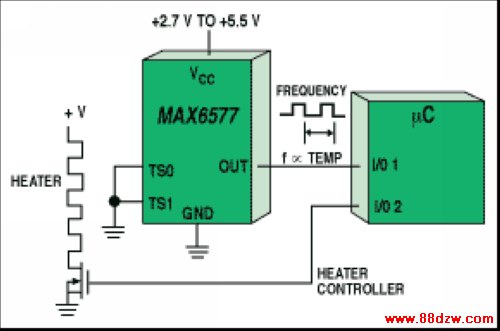Temperature Sensor ICs Simplif
[09-13 17:03:24] 来源:http://www.88dzw.com 控制技术 阅读:8873次
文章摘要:This digital I/O class of devices finds widespread use in servers, battery packs, and hard-disk drives. Temperature is monitored in numerous locations to increase a server's reliability: at the motherboard (which is essentially the ambient temperature inside the chassis), inside the CPU die, and
Temperature Sensor ICs Simplif,标签:计算机控制技术,工厂电气控制技术,http://www.88dzw.comThis digital I/O class of devices finds widespread use in servers, battery packs, and hard-disk drives. Temperature is monitored in numerous locations to increase a server's reliability: at the motherboard (which is essentially the ambient temperature inside the chassis), inside the CPU die, and at other heat-generating components such as graphics accelerators and hard-disk drives. Battery packs incorporate temperature sensors for safety reasons and to optimize charging profiles, which maximizes battery life.
There are two good reasons for monitoring the temperature of a hard-disk drive, which depends primarily on the speed of the spindle motor and the ambient temperature: The read errors in a drive increase at temperature extremes, and a hard disk's MTBF is improved significantly through temperature control. By measuring the temperature within the system, you can control motor speed to optimize reliability and performance. The drive can also be shut down. In high-end systems, alerts can be generated for the system administrator to indicate temperature extremes or situations where data loss is possible.
Analog-Plus Temperature Sensors
"Analog-plus" sensors are generally suited to simpler measurement applications. These ICs generate a logic output derived from the measured temperature and are distinguished from digital I/O sensors primarily because they output data on a single line, as opposed to a serial bus.In the simplest instance of an analog-plus sensor, the logic output trips when a specific temperature is exceeded. Some of these devices are tripped when temperature rises above a preset threshold, others, when temperature drops below a threshold. Some of these sensors allow the temperature threshold to be adjusted with a resistor, whereas others have fixed thresholds.
The devices shown in Figure 6 are purchased with a specific internal temperature threshold. The three circuits illustrate common uses for this type of device: providing a warning, shutting down a piece of equipment, or turning on a fan.

Figure 6. ICs that signal when a temperature has been exceeded are well suited for over/undertemperature alarms and simple on/off fan control.
When an actual temperature reading is needed, and a microcontroller is available, sensors that transmit the reading on a single line can be useful. With the microcontroller's internal counter measuring time, the signals from this type of temperature sensor are readily transformed to a measure of temperature. The sensor in Figure 7 outputs a square wave whose frequency is proportional to the ambient temperature in Kelvin. The device in Figure 8 is similar, but the period of the square wave is proportional to the ambient temperature in kelvins.

Tag:控制技术,计算机控制技术,工厂电气控制技术,控制技术
《Temperature Sensor ICs Simplif》相关文章
- › Using Analog Temperature Senso
- › Temperature Sensor ICs Simplif
- › Compact DWDM laser Temperature
- › Measuring Temperature with the
- 在百度中搜索相关文章:Temperature Sensor ICs Simplif
- 在谷歌中搜索相关文章:Temperature Sensor ICs Simplif
- 在soso中搜索相关文章:Temperature Sensor ICs Simplif
- 在搜狗中搜索相关文章:Temperature Sensor ICs Simplif
分类导航
最新更新




 当前位置:
当前位置: